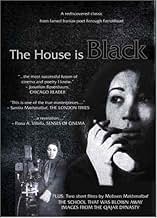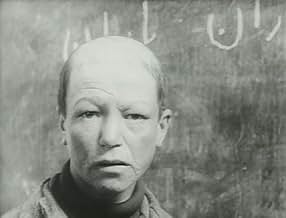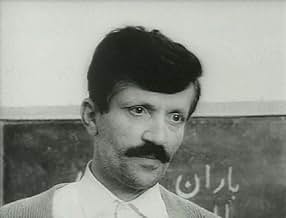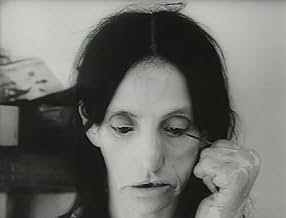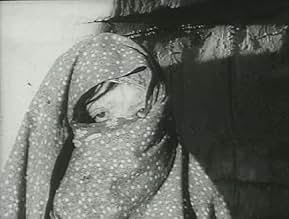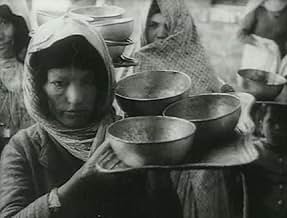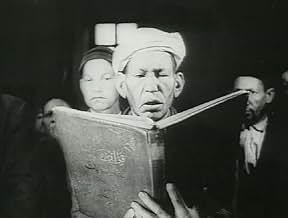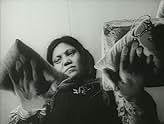Ajouter une intrigue dans votre langueSet in a leper colony in the north of Iran, The House is Black juxtaposes "ugliness", of which there is much in the world as stated in the opening scenes, with religion and gratitude.Set in a leper colony in the north of Iran, The House is Black juxtaposes "ugliness", of which there is much in the world as stated in the opening scenes, with religion and gratitude.Set in a leper colony in the north of Iran, The House is Black juxtaposes "ugliness", of which there is much in the world as stated in the opening scenes, with religion and gratitude.
- Réalisation
- Scénario
- Casting principal
Forugh Farrokhzad
- Narrator
- (non crédité)
Ebrahim Golestan
- Narrator
- (non crédité)
Hossein Mansouri
- Self
- (non crédité)
Avis à la une
`There is no shortage of ugliness in the world.' the opening voice-over states as we see a horribly disfigured woman staring into a mirror. And by the film's end, we truly get an understanding of what she means.
`Khaneh siah ast' (The House is Black), written, directed and edited in 1963 by Forugh Farrokhzad is a brilliant piece of work done on an issue that has hardly been portrayed in any kind of film, fiction or non. Filmed in B&W on location somewhere on a Middle Eastern island, the film portrays a rapid series of events during the everyday lives of all of its inhabitants that are suffering from various stages of leprosy.
Cinematographer Soleiman Minasian uses mainly natural light and captures the pure essence of what living with leprosy is actually like. It is very startling. All the more startling due to Farrokhzad's rapid editing and cutting and disorienting flash-pans. And although the film is a documentary, there are certain scenes, which are entirely fabricated and contrived. One scene in particular is an actual tracking shot through a classroom where there is a coherent edited sequence of dialogue spoken between a teacher and his student. And although no one in the film is an actor, the scene was indeed scripted.
The reason the film is so brilliant is because Farrokhzad juxtaposes the images with extremely religious voice-over narration. Each individual that has leprosy prays to God and gives thanks for being alive in this world. It is harshly ironic that all living lepers are giving thanks and praise to a God that forces them to live through painful physical suffering everyday of their life.
They say leprosy is a curable disease, however, the impact and feeling you get from experiencing this film, is not.
`Khaneh siah ast' (The House is Black), written, directed and edited in 1963 by Forugh Farrokhzad is a brilliant piece of work done on an issue that has hardly been portrayed in any kind of film, fiction or non. Filmed in B&W on location somewhere on a Middle Eastern island, the film portrays a rapid series of events during the everyday lives of all of its inhabitants that are suffering from various stages of leprosy.
Cinematographer Soleiman Minasian uses mainly natural light and captures the pure essence of what living with leprosy is actually like. It is very startling. All the more startling due to Farrokhzad's rapid editing and cutting and disorienting flash-pans. And although the film is a documentary, there are certain scenes, which are entirely fabricated and contrived. One scene in particular is an actual tracking shot through a classroom where there is a coherent edited sequence of dialogue spoken between a teacher and his student. And although no one in the film is an actor, the scene was indeed scripted.
The reason the film is so brilliant is because Farrokhzad juxtaposes the images with extremely religious voice-over narration. Each individual that has leprosy prays to God and gives thanks for being alive in this world. It is harshly ironic that all living lepers are giving thanks and praise to a God that forces them to live through painful physical suffering everyday of their life.
They say leprosy is a curable disease, however, the impact and feeling you get from experiencing this film, is not.
I noticed some reviewers thought that MAYBE this film is about something other than its obvious subject, leprosy. Well, after seeing it, I think it's about leprosy. Sure, there's a bit more to it than that, but the film really does seem to be about lepers.
As the film progresses, various Muslim prayers and quotes from the Koran are read either by the narrator or by some of the subjects in the film. These are all about beauty and grace of God and are a sharp contrast to the lepers you see throughout the film. Although they appear very pitiful, most seem rather happy, though the film doesn't appear to try to say 'hey, it's great to be a leper'--more that in this day of medical miracles, Hansen's Disease (leprosy) IS curable and it's a horrible thing that so many go untreated. Forugh Farrokhzad (who wrote, directed and appears in the film) does not discuss WHY so many in her native Iran were untreated at the time--just that there is a SHARP contrast between the goodness of God and the plight of these people.
This film is unpleasant and will make you think. However, it's a very well made film--one that strikes the viewer with sadness and forces you to look into the ugly face of the illness.
As the film progresses, various Muslim prayers and quotes from the Koran are read either by the narrator or by some of the subjects in the film. These are all about beauty and grace of God and are a sharp contrast to the lepers you see throughout the film. Although they appear very pitiful, most seem rather happy, though the film doesn't appear to try to say 'hey, it's great to be a leper'--more that in this day of medical miracles, Hansen's Disease (leprosy) IS curable and it's a horrible thing that so many go untreated. Forugh Farrokhzad (who wrote, directed and appears in the film) does not discuss WHY so many in her native Iran were untreated at the time--just that there is a SHARP contrast between the goodness of God and the plight of these people.
This film is unpleasant and will make you think. However, it's a very well made film--one that strikes the viewer with sadness and forces you to look into the ugly face of the illness.
Every man is as ugly as the latter in the eyes of a beast. On the outside we are all humans. Inwardly we are all humans. Human suffering is inevitable, thus universal. As well as happiness.
It was the only movie made by Forough Farrokhzad.
A documentary of 20 minutes length; actually it is a documentary only at the first level of meaning: the disturbing images from a leper colony are meditated in verses that partner what's flowing on the screen. Fragments from Psalms, from Koran, from her own poetry. And her stanzas, sometimes in sync with the images, some times in counterpoint, always challenging the versets from the sacred books. One of the greatest poets of the twentieth century, that's what I believe Forough Farrokhzad is.
This movie is a cinematic poem: empathy for the extreme suffering, desolation that we cannot escape from our condition, and, in the same time, awe in face of the beauty of creation.
I think the key of the movie is done by two verses:
Who is this in hell Praising you, O Lord?
The hell is also part of the world; and it is ultimately beautiful because world is beautiful.
This is extraordinary here in the movie: the subtle impulse to see the Universe as beautiful in all its dimensions, even in its ugliest expressions - to see the splendor of the human condition, even in its most horrible shape.
Or maybe the verses tell us something slightly different: as they are in turn fearful, desolate, bitter, pessimistic, sarcastic against God and praising God, it is here the honesty and the courage of the poet to recognize having all these contradictory feelings. And this speaks indeed about the splendor of the human condition: to encompass everything, to assume all contradictions, to be their sovereign - as the Universe is.
A documentary of 20 minutes length; actually it is a documentary only at the first level of meaning: the disturbing images from a leper colony are meditated in verses that partner what's flowing on the screen. Fragments from Psalms, from Koran, from her own poetry. And her stanzas, sometimes in sync with the images, some times in counterpoint, always challenging the versets from the sacred books. One of the greatest poets of the twentieth century, that's what I believe Forough Farrokhzad is.
This movie is a cinematic poem: empathy for the extreme suffering, desolation that we cannot escape from our condition, and, in the same time, awe in face of the beauty of creation.
I think the key of the movie is done by two verses:
Who is this in hell Praising you, O Lord?
The hell is also part of the world; and it is ultimately beautiful because world is beautiful.
This is extraordinary here in the movie: the subtle impulse to see the Universe as beautiful in all its dimensions, even in its ugliest expressions - to see the splendor of the human condition, even in its most horrible shape.
Or maybe the verses tell us something slightly different: as they are in turn fearful, desolate, bitter, pessimistic, sarcastic against God and praising God, it is here the honesty and the courage of the poet to recognize having all these contradictory feelings. And this speaks indeed about the splendor of the human condition: to encompass everything, to assume all contradictions, to be their sovereign - as the Universe is.
10evolv
One must consider why the religious emphasis is there. Everyone in this film has a message; the Iranians are known for their no frills directness when it comes to film-making.What is Farrokhzad saying about religion?
Additionally; is this film entirely about leprosy, or does it hint toward other kinds of corruption?
Is the previous reviewer certain that there were scripted scenes? I admit it's been a while so I can't clearly remember; however another rule of Iranian film is that can be very hard to distinguish the scripted and the natural. If you want to test this, check out Kiarostami's wonderful "Close-up" or Samira Makhmalbaf's "Apple". The events are real as are the actors, beyond that...well just watch em. With your thinking hat on.
OK i'm done.
Additionally; is this film entirely about leprosy, or does it hint toward other kinds of corruption?
Is the previous reviewer certain that there were scripted scenes? I admit it's been a while so I can't clearly remember; however another rule of Iranian film is that can be very hard to distinguish the scripted and the natural. If you want to test this, check out Kiarostami's wonderful "Close-up" or Samira Makhmalbaf's "Apple". The events are real as are the actors, beyond that...well just watch em. With your thinking hat on.
OK i'm done.
Le saviez-vous
- AnecdotesIt was the only film Farrokhzad directed before her death in 1967. During shooting, she became attached to a child of two lepers, whom she later adopted.
- ConnexionsFeatured in Cinema Iran (2005)
Meilleurs choix
Connectez-vous pour évaluer et suivre la liste de favoris afin de recevoir des recommandations personnalisées
Détails
- Durée20 minutes
- Couleur
- Mixage
- Rapport de forme
- 1.37 : 1
Contribuer à cette page
Suggérer une modification ou ajouter du contenu manquant

